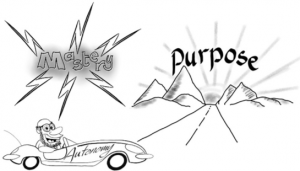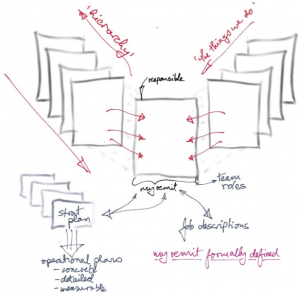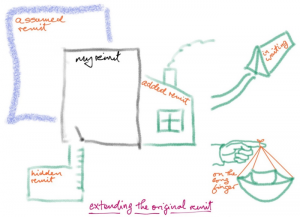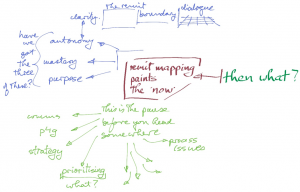Remit mapping
By Michael Sinnott, Director of Agile
 The idea at the heart of remit mapping is that clarity of purpose helps individuals and teams do good work and be a good place to work, so key question is “Are we clear on our purpose?”
The idea at the heart of remit mapping is that clarity of purpose helps individuals and teams do good work and be a good place to work, so key question is “Are we clear on our purpose?”
This leads to recognising that an individual or team’s remit, the tasks or area of responsibility formally assigned to them, is part of how ‘purpose’ is broadly framed. It quickly becomes clear that lots of factors influence the evolution of remit over time – some planned, some accidental, some organic, some not obvious?
If my remit is a key part of how I get clarity of purpose then what, in effect, is my remit now? Am I clear? Are others clear?
How do we step back and look at this?
Our ‘my remit’ model looks to what I am responsible for, my autonomy and accountability in that, how this connects with my team and line management, and how this in turn connects with the University’s structures. My remit, broadly, provides me with the purpose of my job.
The same logic applies when looking at teams – remit provides purpose – and where that remit comes from helps show how what a team does contributes to the broader contexts – units, School, College, and University.
Back to clarity of purpose. Why focus on this? Purpose is part of the ‘mastery / purpose / autonomy’ model popularised by Dan Pink when looking at two things – what it takes to create a satisfying and motivational work environment and, consequently, what it takes to enable strong performance.

In this article we look at purpose, and how remit mapping helps in clarifying it.
You can take a short remit mapping training session with UCD Agile or work with Agile on your own mapping session if you want see how you might use this with your own team. The training is short, with the skills in running sessions learned through experience.
Lots of factors influence how remits develop and evolve over time. The point here is not that you need to figure out what all the influences are – the point is that you need to stand back and see just what your remit has become, in practice, under all these various influences. This is particularly true for teams where both what the team is responsible for and what the individuals in the team are responsible for can evolve under many different influences.
Remit mapping helps you paint the ‘now’. Just what is my remit now? Just what is our team’s remit now? Do we all share the same clarity on this? Do those around us clearly understand? How does what I do, and what we do, contribute?
 Remit mapping workshops themselves are quite simple.
Remit mapping workshops themselves are quite simple.
They begin by talking about Dan Pink’s mastery, autonomy and purpose. If you buy in to that idea then checking to see whether clarity of purpose or not makes sense, and the link between clarity of purpose and the idea of remit, and its evolution, is a practical way to delve into this.
Then comes the easy bit in a session – people describing what they do. They are always the experts in what they do – nobody knows better, nobody has more insight – so the team builds its own remit map.
There are six elements in a remit map.

My remit – what I was formally given
Added remit – what I have been given since
Hidden remit – the things I do that are not known by others but are part of what I do
Assume remit – the things others assume I do… but I don’t
Remit in waiting – areas and activities I know are coming my way and will chagne my remit
Remit on the long finger – areas and activities I am responsible for… but I don’t do
This is the blank map that a remit mapping workshop populates, with such sessions often being two hours or so. More work may follow, but that’s what it takes to map ‘now’. This ‘now’ the person or team builds in a session represents the consequence of all the various influences that shaped it over time.
Now that we know the ‘now’, what next?

There is always a reason why a team does remit mapping in the first place. Remit mapping is the pause before you head somewhere. Every session is unique because each team is unique.
Agile provides training in remit mapping – more of the theory behind the above. Contact agile@ucd.ie if you want to know more or check http://www.ucd.ie/agile/ourservices/training/remitmapping/
Agile is happy to talk to you about how you might use remit mapping – every context is different, every journey from ‘now’ unique. Contact us at agile@ucd.ie or Michael Sinnott or Olga Murdoch directly.
Michael Sinnott
UCD Agile
